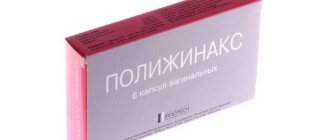Inflammatory diseases of the genital tract are common companions of women. The provocateur is a nonspecific opportunistic flora. Normally, it is present in small quantities in the vagina, but a decrease in the body's defenses allows it to multiply and cause inflammation. The problem cannot be left without treatment. Inflammation can progress and spread to the overlying parts of the reproductive system. In this situation, gynecologists often prescribe multi-component suppositories. The instructions for using Polygynax suppositories emphasize that the drug belongs specifically to this category.
Pathological discharge from the genital tract and itching are the first symptoms that speak in favor of an inflammatory reaction. But an accurate diagnosis is impossible without examination. For diagnosis at the initial stage, it is enough to visit a gynecologist so that he takes a smear on the vaginal microflora.
What is Polygynax?
Essentially, it is a complex antimicrobial agent that contains neomycin, polymyxin B and nystatin. The first 2 components have a detrimental effect on a number of bacterial pathogens:
- Pseudomonas aeruginosa;
- Staphylococcus aureus;
- Ureaplasma urealiticum;
- Escherichia coli;
- Enterococcus fecium;
- Haemophilus influenzae;
- Enterobacter Aerogenes;
- Koch stick;
- Proteus vulgaris;
- Klebsiella pneumonia.
Nystatin destroys fungal forms:
- Histoplasma capsulatum;
- Cryptococcus;
- Candida.
Attention! The drug is useless against streptococcal and anaerobic infections.
Quite often, the pathology of the female genital organs is caused by a combination of both groups of pathogens - fungi and bacteria; it is for such cases that products like Polygynax were developed. In addition, suppositories are convenient for preventing infection during gynecological operations.
Why is the drug prescribed?
The medicine is used to get rid of pathogenic pathogens for the following diagnoses:
- Cervicitis – infection of the cervix;
- Vulvovaginitis – inflammation of the vagina and external genitalia;
- Crevicovaginitis is a combination of pathology of the cervix and vagina;
- Colpitis of various natures, when the main cause for concern is abnormal vaginal discharge;
- Candidiasis or thrush.
Any diseases that are characterized by the proliferation of pathogenic microbes and fungi of the female genital organs can be treated with Polygynax suppositories.
For preventive purposes the drug is used:
- In preparation for hysteroscopy of the uterus;
- Before installing an IUD;
- Before and after cauterization of cervical erosion;
- Before gynecological surgery;
- Before abortion;
- At the final stage of pregnancy, to prevent infection of the fetus during childbirth.
Such measures prevent the development of infection and its penetration higher into the genital organs during various manipulations, thereby reducing the risk of complications.
Interesting fact! A study in which 25 women with inflammation of the vagina and cervix took part revealed not only their complete recovery within 12 days, but also the restoration of normal flora of the genital organs, which is completely impossible when using oral antibacterial agents.
Duration of treatment
For preventive purposes, in preparation for operations and other gynecological procedures, 6 days of using suppositories at night are prescribed. After the procedure, a similar course may be recommended.
For the treatment of infections, Polygynax is given for 12-20 days, depending on the severity of the pathology and the pathogen. As a rule, candidiasis requires long-term therapy. Longer treatment does not make sense; if there is no effect, the tactics are revised and other drugs are prescribed.
Attention! If a woman forgets to put a candle on one of the days of the course, the next day treatment continues as usual. No dosage increase required!
With alcohol
Doctors who actively use this drug in their practice have not reached a consensus on its compatibility with alcohol . Some of them are convinced that the combination of any antibacterial drugs with alcoholic beverages, at best, neutralizes the effects of treatment, and at worst, can lead to the formation of various negative complications. Others, based on the actual absence of the active ingredients of the drug in the systemic circulation, do not see in this combination any negative effect of alcohol on the therapy. It is worth noting that both agree on the adverse effects of alcohol on the human body in principle and do not recommend taking such drinks for any pathological conditions, especially in large quantities.
What type of discharge occurs after using Polygynax?
First, let's look at the normal phenomenon when, in the morning, taking a vertical position, the patient notices copious thick oily discharge. The composition of the suppository includes substances that provide the form and deliver the active components to their destination, then they dissolve and leave the vagina in liquid form. The contents of the drug can be white, cream, yellow and brownish, so a similar color of discharge is normal if it is not accompanied by an unpleasant odor, pain, burning and itching.
Next, we will look at pathological discharge after treatment with Polygynax.
White
Abundant ones with a cheesy consistency and the smell of fermented milk products indicate the development of candidiasis. They are accompanied by itching and burning. If such symptoms are observed in the first 3 days of using suppositories, do not be alarmed; not enough time has passed for a therapeutic effect. When white discharge occurs at the final stage of treatment or after it, this indicates either re-infection or that the drug has not done its job and other means are required.
Yellow
Abundant leucorrhoea of this color with an unpleasant odor, coupled with itching and pain, is a sign of an acute bacterial infection. Perhaps the pathology is caused by a pathogen against which Polygynax is powerless.
Greens
Such leucorrhoea in combination with a fishy odor, itching, urination disorders, hyperemia of the vulva and vagina indicates acute infectious inflammation. Trichomoniasis, gonorrhea and other diseases are characterized by similar symptoms. The reason is similar - suppositories are powerless in this case, or the infection occurred after or during therapy.
Bloody
It may be pink, red, clotted or brown discharge. In a state of inflammation, the mucous membrane is easily damaged, in combination with increased blood supply, this leads to the appearance of leucorrhoea with blood. Even the insertion of a suppository can sometimes cause microtrauma. However, heavy discharge may indicate the presence of diseases in a woman’s body:
- Cervical erosion;
- Endometriosis;
- Polyps;
- Ectopic pregnancy;
- Polycystic ovary syndrome;
- Endocervicitis;
- Hormonal imbalance.
In such cases, Polygynax only identifies existing pathologies. The doctor will decide whether it is worth continuing treatment. For example, during erosion, light bleeding is considered normal, as well as after cauterization. In this case, discontinuation of the drug is not required.
Attention! Bleeding may be the result of damage to the mucous membrane during sexual intercourse, so you will have to abstain from sex during treatment.
Red and pink discharge in a pregnant woman after taking Polygynax
During the period of bearing a child, the mucous membrane becomes loose and easily damaged, and the blood supply to the tissues increases significantly at this time. Therefore, any mechanical or chemical impact can lead to microtrauma and the appearance of blood in the discharge. However, this symptom should not be ignored. Polygynax is not the safest drug for a pregnant woman, so it is advisable to replace it with another one.
Carefully! The use of any suppositories in the 1st trimester is dangerous and can cause miscarriage and other complications.
Why is Polygynax still prescribed when carrying a child? The fact is that no studies have been conducted on the effects of the active components of the drug on the fetus and pregnancy and the concerns are speculative. At the same time, the doctor understands exactly what threat the infection poses to the child. Considering the risk ratio, it turns out that the drug is not as terrible as the consequences of the disease. Therefore, Polygynax and its analogues are prescribed in the 3rd trimester of pregnancy (and sometimes in the second) for infections.
The appearance of blood in the discharge of a woman expecting a child is regarded as a threat of miscarriage or premature birth, so suppository therapy is stopped.
The most effective remedies for intimate itching in women
Itching in the vagina very often haunts women. Therefore, it is important to choose drugs to eliminate it that eliminate the cause of its appearance and help you completely forget about the problem. That is why it makes sense to discuss five popular drugs today, which are often prescribed by gynecologists, as they effectively eliminate vaginal itching and provide the desired relief.
Klion D
Klion D is a drug that is prescribed when a woman complains of vaginal itching. Discomfort can be caused by fungi, trichomonas and protozoa that disrupt the vaginal flora.
The active ingredients in the drug Klion D are metronidazole, as well as miconazole. The first active ingredient kills bacteria and has an antiprotozoal effect.
The second active ingredient, which contains Klion D, kills the fungus in the vagina.
This drug is presented in only one form - in the form of tablets. This remedy acts locally. The maximum concentration of the active ingredients of the drug in the vagina is observed after 6-12 hours after administration of the treatment tablet.
Important! Pregnant women should first consult a doctor before using this drug. Why? Since metronidazole, being one of the active ingredients, easily reaches the fetus, overcoming the existing placental barrier.
It is also absorbed into breast milk. That is why this drug is not prescribed to expectant mothers before the 12th week of pregnancy.
In the second and third trimester, the doctor may prescribe this drug, but on the condition that the benefits of its use by the mother will outweigh the possible risks for the baby growing in the womb.
Trichomoniasis is treated with these tablets for 10 days. But doctors warn that the sexual partner should also be treated at the same time (he should be given metronidazole tablets to take orally). The instructions indicate that if necessary, the course of treatment can be repeated.
Thrush (candidiasis) is also treated with a 10-day course of Klion D tablets. They should be inserted into the vagina before going to bed. If one course of treatment was not enough, you can repeat it later.
Terzhinan
Terzhinan is another remedy that is prescribed to women who are bothered by itching. This combination drug is prescribed if sanitization of the vagina is necessary, that is, its cleansing from harmful microbes, fungi and the inflammatory process. The drug has an aggressive effect on fungi and pathogenic bacteria without disturbing the vaginal microbiocenosis.
There are four main active ingredients in it:
- ternidazole – a substance that kills fungi, anaerobic bacteria, and Trichomonas;
- neomycin – a substance that destroys gram-positive and gram-negative vaginal bacteria;
- nystatin is a well-known antifungal antibiotic that works well against fungi of the genus Candida;
- prednisolone is a substance that relieves inflammation and any allergic manifestations.
Trichomoniasis, candidiasis and mixed vaginitis are treated with this drug for a 10-day period. Terzhinan should be systematically injected into the vagina (it is better to do this daily in the evening).
For prevention, tablets can be used for 6 days. If mycosis is confirmed, it makes sense to take Terzhinan tablets for 20 days.
The negative side of the drug is that a woman usually feels a burning sensation immediately after deep insertion of the pill. But it passes quickly.
Important! In the first trimester, gynecologists do not advise women to use Terzhinan. It can only be used from the 2nd trimester. During breastfeeding, vaginitis, trichomoniasis and candidiasis should also not be treated with this remedy, since its active substances can pass into breast milk.
Gynecologists who advise treating vaginal itching with this drug insist on parallel treatment of the sexual partner.
Neo-Penotran
If vaginal itching is caused by vaginal candidiasis, trichomoniasis, vaginosis, or mixed vaginal infections, the gynecologist may prescribe Neo-Penotran to the fairer sex. Doctors like to prescribe this drug because it is offered in the form of suppositories and is therefore convenient.
Neo-Penotran contains Miconazole, Metronidazole and other excipients. It is usually prescribed when the woman has undergone research and the doctor has accurately determined the cause of the annoying itching.
Neo-Penotran is not recommended when:
- there is pregnancy (its first trimester);
- the girl is under 18 years of age;
- there are problems with the liver;
- there is bleeding from the genitals;
- diagnosed with cancer.
The course of treatment with the drug is 10 days. The instructions say that people who are prone to allergies may have:
- burning;
- hyperemia of the mucous membrane;
- increased vaginal discharge.
Important! The instructions for this drug say that in parallel with treatment, the woman should also treat her partner for infections transmitted after sexual intercourse. If this recommendation is ignored, the effect of this drug will not last long.
Polygynax
In addition to the drugs listed above, Polygynax is often prescribed to eliminate vaginal itching. The described remedy is a drug common in gynecology that acts locally. Polygynax has antifungal and pronounced antibacterial effects.
It contains three main active ingredients - neomycin, nystatin, and polymyxin B. In combination, these three main active ingredients completely destroy pathogenic gram-positive and gram-negative microbes and kill Candida fungi.
Polygynax is prescribed if diagnosed:
- nonspecific vulvovaginitis;
- fungal vaginitis;
- mixed vaginitis;
- cervical vaginitis.
Doctors also recommend this remedy before operations and manipulations on the cervix, before intrauterine diagnostic medical procedures, as well as before the birth process. For prevention, they should be treated for 6 days. For treatment purposes, it is used for 12 days.
There is also a negative side to this drug - these are possible allergic manifestations, itching, erythema of allergic origin. Gynecologists do not prescribe this medication in the 1st trimester of pregnancy, during the period when a woman is breastfeeding, or when a woman is sensitive to one or more drugs.
Important! In the second and third trimester, this drug can be prescribed, but only when the benefits to the mother significantly outweigh the risks that arise when the drug affects the developing fetus.
What should you do if you have discharge?
If in any doubt, the patient should visit a gynecologist and tell him about the disturbing symptoms. Next, the specialist takes a number of measures to identify and eliminate the problem.
Diagnostics
First, an examination is carried out on a chair, where the doctor will make sure of the presence and nature of the discharge. Perhaps these are indeed the remains of a candle. At the same moment, a smear of the flora is taken to determine the presence of inflammation through microscopic examination. Further, the following measures may be necessary:
- Colposcopy and treatment of the cervix with special preparations to detect erosion.
- Bacterial culture to determine the pathogenic agent and select an effective antibacterial agent.
- PCR analysis helps to identify chlamydia and mycoplasma that are invisible during normal microscopic examination.
- An ultrasound is needed to exclude polyps, ectopic pregnancy, polycystic ovary syndrome and other diseases.
The full range of diagnostics may be different for each woman and is prescribed by a doctor.
Treatment
If the discharge is not a sign of secondary infection, the use of Polygynax is continued. For pregnant women, different therapy is selected. If suppositories are ineffective, a drug is prescribed based on the results of bacterial culture; as a rule, these will be tablets for oral administration. For bleeding associated with erosions, polyps, endometriosis and polycystic ovary syndrome, therapy requires adjustment; plans may change dramatically or other drugs will be added.
Carefully! Self-medication in such a situation is simply pointless, because even determining the cause of leucorrhoea with the help of tests can be difficult.
Prevention of discharge while using Polygynax
Sometimes complications and side effects are a consequence of incorrect use of the drug, so you must follow a number of rules:
- Place candles after washing the external genitalia with clean hands.
- Refuse intimate relationships. As a last resort, contact should occur before using the drug, and not after.
- The sexual partner is also treated, even if he has no symptoms. For these purposes, there are drugs in the form of a tablet that is taken once, for example, Fluconazole. Or creams for treating the genitals.
- Do not increase the dosage or duration of treatment. This makes no therapeutic sense and may even be harmful.
- During the treatment period, you cannot use other local medications without permission or douche.
- The product continues to be used during menstruation.
- Polygynax is prohibited in the 1st trimester of pregnancy and up to 16 years of age.
- The best time to take it is at night, so that the candle has time to dissolve and the active ingredients to take effect. It is recommended to lie down for 20-30 minutes without getting up.
special instructions
Before prescribing therapy using Polygynax capsules, it is necessary to refer the patient to a procedure for taking a smear from the vaginal mucosa with further bacteriological analysis in order to determine the causative agent of the disease and its sensitivity to the effects of the active ingredients of the drug.
The duration of treatment should be limited to the time necessary for complete recovery (do not use the drug for longer than necessary). This recommendation is intended to prevent the possible emergence of drug resistance in pathological microorganisms and reduce the risk of reinfection .
At the entire stage of therapy, the patient is not recommended to use latex barrier contraceptives ( condoms, caps).
A woman undergoing treatment with Polygynax capsules should not interrupt the therapeutic course during menstruation.
The attending physician must warn the patient about the need to convey to him all the information regarding the first manifestation or worsening of any side effects described in the instructions, or the detection of other negative phenomena observed during the treatment process.
The effects of the capsules do not have such a negative impact on the patient’s body that could interfere with her ability to operate machinery or drive vehicles.











